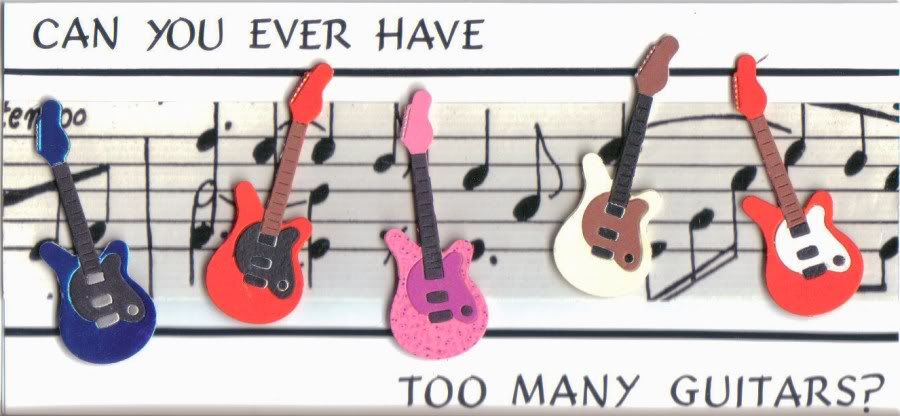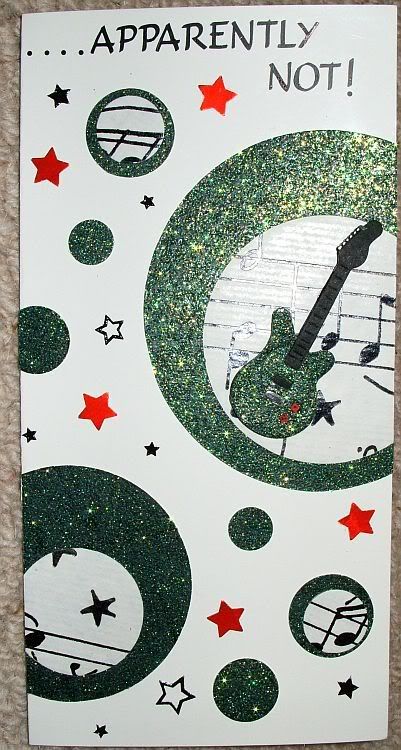
Ancient Mariner
-
Posts
1,106 -
Joined
-
Last visited
Content Type
Profiles
Forums
Events
Shop
Articles
Posts posted by Ancient Mariner
-
-
Yup, the old issue of rolling the volume off darkens the tone thang. Oddly though, I've only ever found 1 guitar (Godin SD) that did it noticeably: all the rest of mine (strats, les pauls, washburn, Godin xtSA) don't do this to an obvious degree. I suspect it's to do with how the tone controls are wired up, and which side of the tone pot relative to the volume control the tone cap sits.
-
I've fixed issues like that with piezo bridges.
The piezo 'crystals' sit between 2 electrodes that pickup the electricity the crystals produce. What happens sometimes is that dirt collects between the crystal and the metal electrode, partially insulating the contact and reducing the volume. the end result is some strings are loud and some soft or even inaudible. Some pickups can be disassembled, the crystals and contacts cleaned and then reassembled.
Not all pickup assemblies can be dismantled, so if it looks like it doesn't come apart then replacement may be the only answer. Unless it's something entirely to do with the internal electronics. -
Better pick a red or white one then.

I went to Matamp for an 'ampfest' organised by a guitar forum. If you've never been it's worth going just to see what they do. We loved their wall of switchable speakers, where you plug your amp head into a switch block that lets you change cabs on the fly. -
[quote name='stevie' post='731020' date='Jan 31 2010, 08:14 PM']I second that. The wire used on pickup coils is so fine that a soldering iron will melt it like a fusewire if it's held on for long.[/quote]
I'm sorry, but that's not true with a normal soldering iron. The wire used on pickup coils is copper, and it won't melt at normal soldering temperatures. The only thing you might do is burn off the lacquer coating if you heat it for a prolonged period (more than the couple of seconds necessary to make a joint). -
I was just looking at that a moment ago. The headstock shape looks just like the Johnny Brooke basses that are a bit cheaper, though the one I saw had block inlays rather than dots. I've got a JB (courtesy of Gafbass on here) and it's good for a cheap bass. Issues with mine are the usual low quality pots (standard on everything sub £300-£400) and could do with a fret level, but that's nothing to moan about at this price point.
-
[quote name='oldslapper' post='726974' date='Jan 27 2010, 10:12 PM']Thanks. That's helpful as I didn't know there was one, I'll check it out.
It would appear that this model had issues that led to various changes to the range. The current Nemesis range is quite different inside. The tech I took it to said that the "ratings" of the various components were not standard either.
I can see this heading for the bin.[/quote]
That's a shame. I can't really help unfortunately as I build valve amps, but don't really know where to start with SS jobbies. -
I've repaired several pickups where the leads have come off, and even re-wired humbuckers for split coil use. There's no problem at all, provided you're not pushing the iron's tip into the coils in any way.
-
I went looking for a schema but my usual sources turned up blank. Next I tried the [url="http://www.eden-electronics.com/forum/default.asp"]Eden forum[/url] and it seems this is not an unusual problem, however the solution given is 'send it back'. Sorry that's of no real help.
-
+1 to that.
-
Good luck with that then. The guys at PMT can get tech work done: not cheap & they send it away. I had an acoustic guitar refretted quite a long time ago by them, but TBH I'm not impressed by the job their tech did. Now I'd probably try to do it myself.
-
For my birthday in 2006 I received this card, having just acquired another strat:

The following July she found me working on this on the kitchen table:

And so I got this card:

Original blogpost [url="http://tertl.blogspot.com/2007/08/chris-has-sense-of-humour.html"]here[/url]. -
What kind of work do you need doing? Is it just action, intonation and neck relief or do they need some nut/fretwork too?
-
Thanks everyone - it does sound interesting.
The mintbox looks like a really cool buffer (and easy to make too).
lemmywinks - I'd love to hear how it turns out. -
Behringer effects are a bit unpredictable - some are good at any price, some just usable and some really nasty. Do do last much better than you'd expect though. I've been gigging a UT100 trem for more than 3 years, and it's fine. The CS100 compressor is OK but the DC-9 unit is terrible (cuts away all the bass). Of course if you make a habit of throwing pedals around then you'll probably break a knob off, just like you would for an older Dano unit.
-
Thank you, yes, that does make sense. Just listened through HiFi speakers, and I can hear how it brings out the crisp airiness without harsh treble.
-
Thank you - so it adds lots of clank and bite (I need to listen on better speakers too)?
-
I just wondered after the comments about poor fretting in the PLEK thread, plus comments about early JD necks being unstable and issues I'm having setting up relief & action on a couple of cheap basses I have. All the comments I've read on here about adjusting relief have been very cautious, suggesting necks need small incremental adjustments and then being allowed to settle 24 hours, slacking strings off before adjusting etc.
-
As an inveterate fiddler with an interest in stuff one finds on the 'bay I've seen a piezo bridge and thought "what if?". Does anyone here use a piezo on a solid bass, and if so, how does it sound and what do you use it for? I wouldn't mind replacing the 'bent bit of tin' type bridge on either of my cheap basses anyway, and this might open up interesting sonic possibilities.
Cheers guys. -
Not being funny, but are you sure about £50 for a bad monkey? They were £30 street price new (I had 2).
-
As far as I'd know they're called compensated nuts because they compensate for the conflict between conventional tuning and the requirements of tempered tuning. I've seen improvised version of the Delft method that were reported to work well. I've also tried a variation of the Feitin method on an acoustic guitar (move the nut forward, slightly altered tuning) that seemed to help a little.
-
Interesting comments: this is the first negative stuff I've heard about Pleking. In the guitar world they're considered to offer better fret work than *most* luthiers working by hand are capable of: certainly when Gibson started using a machine a couple of years back everyone breathed a big sigh of relief when they started shipping guitars with consistently acceptable frets. The point about them is that they measure the neck under full string tension and then cut the frets, ensuring that even an iffy neck plays acceptably. However at a very high cost it's almost impossible to justify: I'm certain that Chandler's priced themselves out of the market (original review in Guitarist mentioned a stainless steel refret and plek treatment at £100 each, but investigating a few months later suggested it would cost a LOT more than that).
I don't think any decent UK luthiers have anything to worry about from plek at this point in time. You have much more to worry about from guys that already have good luthiery skills losing their ordinary jobs and trying to make a bit of money setting up in competition. -
You know, I was completely convinced the Machina dynamica site was a spoof, right up until the last couple of posts here (and I'm STILL pretty sure it is).
-
The settings won't affect the amp because the speaker will present a constant load. The idea of having a tone control in the speaker leaves me with mixed feelings, since most amps have a perfectly good set of tone controls to begin with, and one would specifically not want tone to change with attenuation. But there's another issue, in that a substantial part of what makes us want to play loud is the behaviour of speakers working hard and the way they sound when they're pushed a bit. I'm not sure this has been thought through very well, although I can't really say without trying the final product.
-
They have gained a reputation for patchy quality in the guitar world over the last few years. Still my make of choice, but certainly not without their faults.

.jpg.518c69c2d9e1581799f3c11301dc2da5.jpg)
jazz bass pick ups - WTF..........?
in Repairs and Technical
Posted
[quote name='AlanP2008' post='735015' date='Feb 4 2010, 01:33 PM']That in itself cannot make any difference. If a pot and a cap were in series, and mounted in a "black box", there would be no way (by measuring electical characteristics from outside the box) to determine which one was first...[/quote]
I'll believe you, but I also can't explain why some guitars & basses have this flaw and some do not.